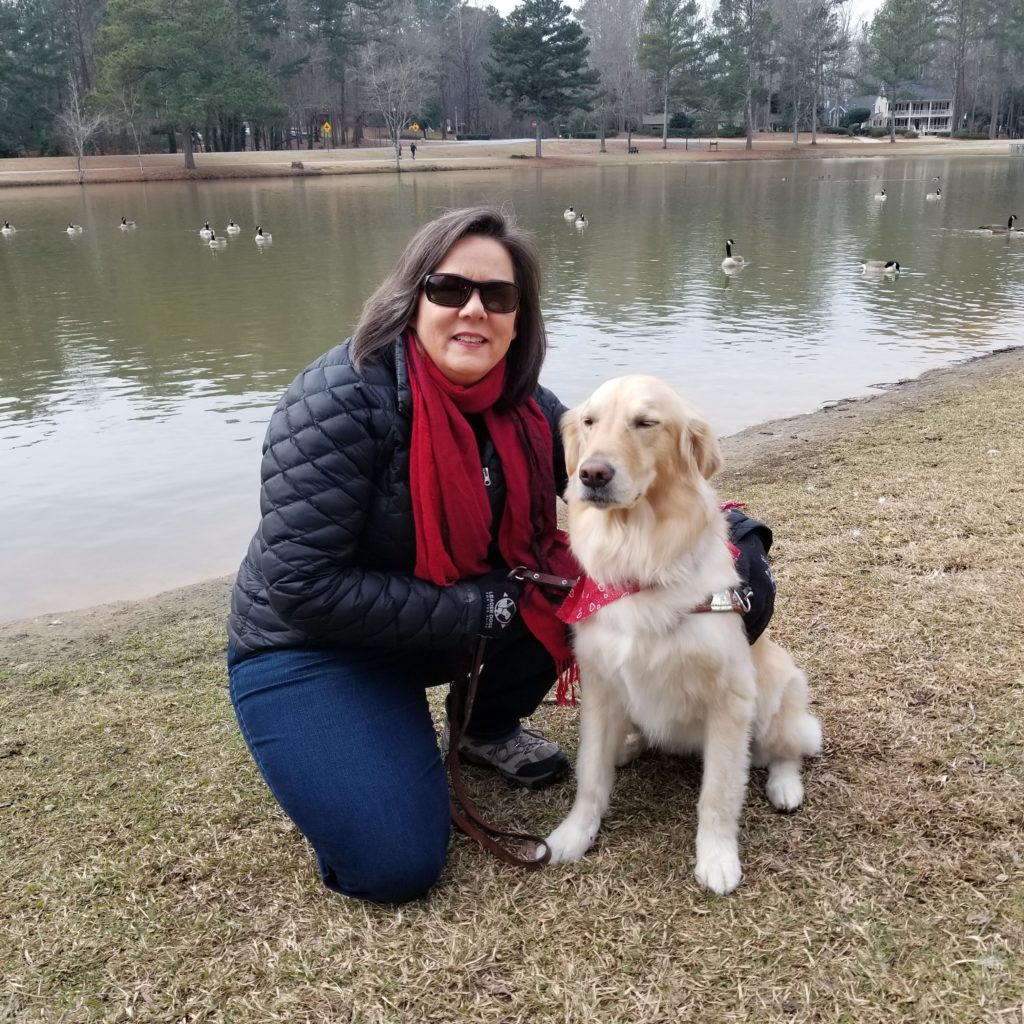Did you know that Retinitis Pigmentosa (RP) is the most common inherited disease of the retina? There is much research being carried out worldwide to find a cure to this condition which affects one in every 4000 people in the United States, and around one in 5000 worldwide. In this 2-part series for RP Awareness Month in February, fellow Peer Advisor and friend, Audrey Demmitt, and myself want to reach out to those people who may be new to RP and need to know we all have been in that beginning phase of shock and denial. But we have also found ways to reach a place of acceptance where we feel much more in control of our lives with this thing they call “blindness.” Here is Part 1 of our two stories with one mission: we can choose to live well and be RP Strong. Stay tuned for Part 2.
Thirty Years with Retinitis Pigmentosa
by Audrey Demmitt, R.N.

I was diagnosed with retinitis pigmentosa (RP) about thirty years ago: It came as a shock out of left field. I did not know much about this disease and there was no one else in my family with it. As is sometimes common with RP, my diagnosis was unclear at first; my vision problems did not fit neatly into the classic understanding and features of RP. Back then, it was assumed I would go blind…maybe as early as my 4th decade.
Now we know there are many types of RP with different presentations and progressions of the disease. While it is still a rare eye condition and it sometimes results in total blindness, so much more is understood about it. Researchers have identified over 286 genes that cause the various forms of RP. And there is even a treatment for one of them. Scientists are making great inroads in this area of research, which gives hope to many.
There came a day in my long acquaintance with this disease when I realized I must learn to live at peace with it. Here are a few suggestions to help someone cope with RP.
1. RP will change your life, but it doesn’t have to ruin your life. You can still have a full life, reach your dreams, accomplish your goals, and enjoy the things that matter most. I worked for 30 years as a nurse with RP. I married, raised three children and now I care for my grandchildren…with my RP. As it turns out, my vision has declined slowly and I still have a useable vision. In fact, I was able to watch my boys play baseball, see my beautiful daughter on her wedding day, and even now, I can look at my grandbabies and see their sweet smiles. Just breathe, enjoy the moment you are in because we don’t know what tomorrow will bring.

2. You will need to make adjustments along the way. About every ten years my vision deteriorated to a new level and I had to learn to adapt. Some adaptations come naturally, and others will require vision rehabilitation training to learn new skills. In the early stages, I knocked a lot of glasses off the counters because I didn’t see them. To solve this problem, I bought brightly colored, plastic drinkware. When I started tripping and falling frequently due to my shrinking field of vision, I knew it was time for white cane training. Adjusting and adapting will help you to survive the RP life.
3. Cultivate flexibility, patience, and gratitude. RP will slow you down and for a time, you will feel less productive and less independent until you acquire new adapted skills. You may have to depend on other people for simple tasks you were able to do on your own. One example of this is relying on others for transportation. Suddenly, you will be living your life according to the schedule of whoever is kind enough to drive you to the grocery store. Be flexible and patient with others as well as yourself. Grow in gratitude by focusing on what you “can” see and “can” do.
4. We are living in a time when amazing technologies make our lives easier. Smartphones with speech, computers with accessibility features, and portable video magnifiers have truly changed the lives of people living with vision loss. I am not a “techy” person and learning new technology does not excite me. But I know it is necessary to keep up with information, communications, and my work. So, I embrace it and am grateful for it.
5. Many hobbies can be adapted for vision impairment. I enjoy cooking, hiking, reading, cross-country skiing, traveling, and crocheting as a visually impaired person. There are alternative ways to read a good book. I learned to ski with a sighted guide. I hike with my guide dog. I use adapted equipment and techniques in my kitchen to safely prepare meals. I crochet with bright lighting, magnifying glasses and muscle memory. You too will find a way to do what you love. Remember to allow yourself time to relax and have fun!
6. There will be hard days, battles to fight, and some hills to climb. I would be remiss if I didn’t mention that. Living with any visual impairment is tough. And with RP, you have to keep adjusting over and over again. You may experience loss, grief, disappointments, battle fatigue and sometimes depression. But every life has these challenges. They are opportunities to grow stronger. Be sure to seek mental health services when you need help over these humps. Take good care of yourself and give yourself a break during tough times.
It is up to each person to decide how they will live with their RP. I hope you will choose to live well and be RP strong.
Additional Information on RP
Retinitis Pigmentosa Research Advances—Foundation Fighting Blindness
Clinical Trials on RP